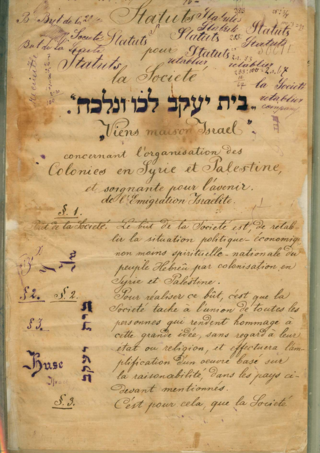
Bilu was a Jewish movement of the late 19th century, fueled predominantly by the immigration of Russian Jews, whose goal was the agricultural settlement of the Land of Israel. Its members were known as Bilu'im, and the movement sought to inspire Jews to migrate to Ottoman Palestine. The Bilu'im rejected progressive notions such as Emancipation and assimilation as viable options for Jewish survival. The movement collapsed as a result of the challenging farming conditions in Palestine and a lack of funding to sustain the settlers.

Moritz Freiherr von Hirsch auf Gereuth, commonly known as Maurice de Hirsch, was a German Jewish financier and philanthropist who set up charitable foundations to promote Jewish education and improve the lot of oppressed European Jewry. He was the founder of the Jewish Colonization Association, which sponsored large-scale Jewish immigration to Argentina.
Moisés Ville is a small town (comuna) in the province of Santa Fe, Argentina, founded on 23 October 1889 by Eastern European and Russian Jews escaping pogroms and persecution. The original name intended for the town was Kiryat Moshe honoring Baron Maurice Moshe Hirsch, but the land agent who registered the settlement translated it to the French-like Moïsesville which was later hispanized to the current Moisés Ville. The town is located about 177 km (110 mi) from the provincial capital, in the San Cristóbal Department and 616 km (383 mi) from Buenos Aires. It had 2,425 inhabitants at the 2010 census [INDEC].
Jews in Philadelphia can trace their history back to Colonial America. Jews have lived in Philadelphia since the arrival of William Penn in 1682.

Congregation Beth Israel is a Reform Jewish congregation and synagogue located at 701 Farmington Avenue, in West Hartford, Connecticut, in the United States.
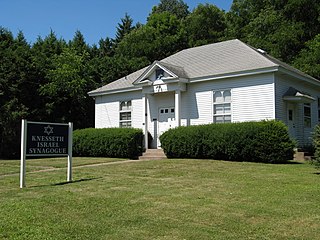
Congregation Knesseth Israel, also known as the Ellington Shul, is a Modern Orthodox synagogue located at 236 Pinney Street in Ellington, Connecticut, in the United States. The congregation was founded in 1906 by a group of Yiddish-speaking Jewish farmers from Russia and Eastern Europe. Its building, dating to 1913, is a rare example of an early 20th-century rural synagogue in the state, and was listed on the National Register of Historic Places in 1995.

Congregation Beth Israel is a Reform Jewish congregation and synagogue, located at 10460 North 56th Street in Scottsdale, Arizona, in the United States. Incorporated in 1920, the congregation affiliated with the Union for Reform Judaism in 1935.
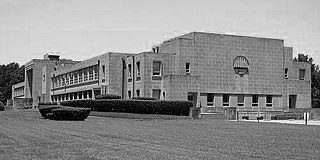
The Baron Hirsch Synagogue, is an Modern Orthodox Jewish congregation and synagogue located at 400 South Yates Road, Memphis, Tennessee, in the United States. Founded in c. 1862 – c. 1864, the congregation underwent tremendous growth in the first half of the 20th century, emerging, in the 1950s, as the largest Orthodox congregation in North America, a position it still holds.
Kol Ami is a Reform Jewish congregation and synagogue located at 225 North Country Club Road, in Tucson, Arizona, in the United States. The congregation was formed through the 2019 merger of Temple Emanu-El and the Congregation Or Chadash, that was established in 1995. The leaders of Temple Emanuel-El and Congregation Or Chadash began discussions about a potential merger in 2018. The merger of the two Reform congregations was consummated the following year, as Kol Ami.
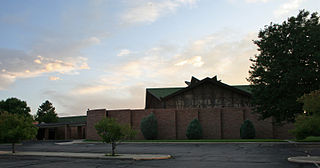
The Temple Emanuel, also known as Congregation Emanuel, is a Reform Jewish congregation and synagogue, located at 51 Grape Street, in Denver, Colorado, in the United States.
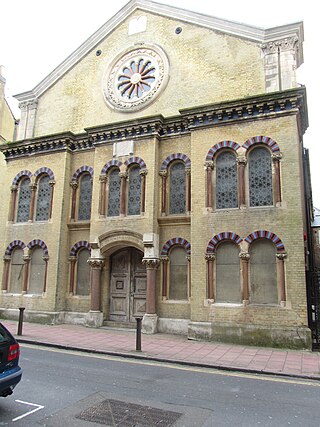
The Middle Street Synagogue is a synagogue in the centre of Brighton, part of the English city of Brighton and Hove. It was the centre for Jewish worship in Brighton and Hove for more than a century. Although it is not in full-time use, the building is still open at certain times, and cultural events frequently take place, as do weddings. It has been listed at Grade II*, reflecting its architectural and historic importance.

Temple De Hirsch Sinai is a Reform Jewish congregation with synagogues at campuses in Seattle and nearby Bellevue, Washington, in the United States. The congregation was formed as a 1971 merger between the earlier Temple De Hirsch and Temple Sinai and is the largest Reform congregation in the Pacific Northwest.

Agudas Achim Synagogue, formally known as Congregation Agudas Achim, is a Reform Jewish synagogue located on Rock Avenue in Livingston Manor, Sullivan County, New York, in the United States. The stucco-sided wooden building was erected in the 1920s to serve the growing Jewish community in that area of the Catskills. It served the large summer population of Jews from the New York City area who vacationed at family resorts in the region.

Temple Beth Israel, sometimes called Charter Oak Temple, is an historic former Reform Jewish synagogue and later church building, now cultural center, located at 21 Charter Oak Avenue, in Hartford, Connecticut, in the United States.

Adolph Walter Rich was a Milwaukee manufacturer, merchant and philanthropist best known for his work in founding the Jewish agricultural colony at Arpin, Wisconsin, United States.

Temple Beth Israel is an historic former Orthodox and Conservative Jewish synagogue building, located at 39 Killingly Drive in the Danielson village of Killingly, Connecticut, in the United States.
Hirsch is a hamlet in the RM of Coalfields in the Canadian province of Saskatchewan and is located about 18 miles east of the city of Estevan along Highway 18. The post office originally opened on 1 December 1893 with the town misspelled as "Hirsh". It closed on 31 March 1970.
The history of Jews in New Jersey started with the arrival of Dutch and English traders and settlers in the late 1600s. According to the Berman Jewish DataBank's 2019 survey, New Jersey is the state with the fourth highest total population of Jews at 545,450, and is also the state with the third highest percent of Jews at 6.1%. This means that New Jersey is home to 7.8% of the American Jewish population.
















